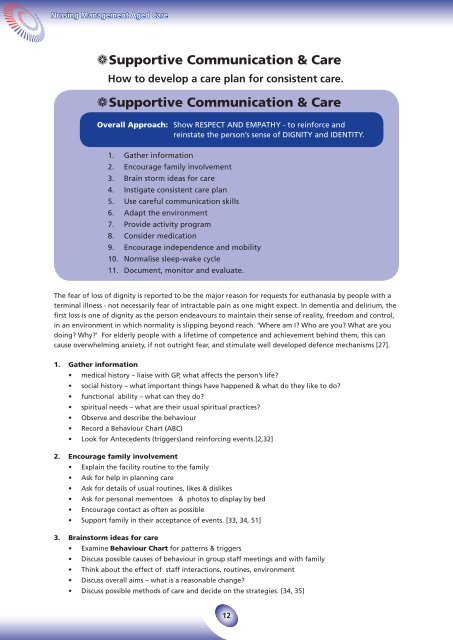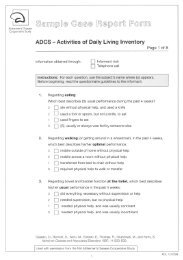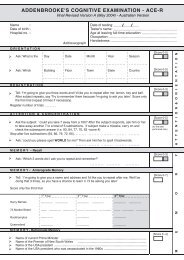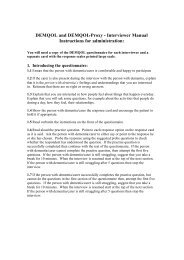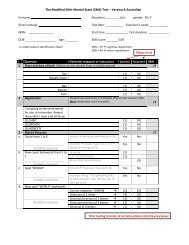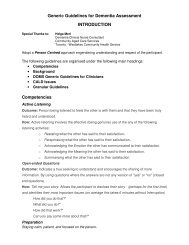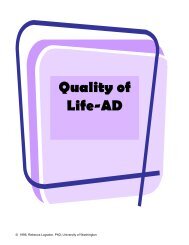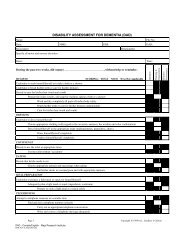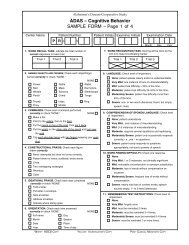Nursing Management of Disturbed Behaviour in Aged Care Facilities
Nursing Management of Disturbed Behaviour in Aged Care Facilities
Nursing Management of Disturbed Behaviour in Aged Care Facilities
You also want an ePaper? Increase the reach of your titles
YUMPU automatically turns print PDFs into web optimized ePapers that Google loves.
<strong>Nurs<strong>in</strong>g</strong> <strong>Management</strong> <strong>Aged</strong> <strong>Care</strong><br />
a Supportive Communication & <strong>Care</strong><br />
How to develop a care plan for consistent care.<br />
a Supportive Communication & <strong>Care</strong><br />
Overall Approach: Show RESPECT AND EMPATHY - to re<strong>in</strong>force and<br />
re<strong>in</strong>state the person’s sense <strong>of</strong> DIGNITY and IDENTITY.<br />
1. Gather <strong>in</strong>formation<br />
2. Encourage family <strong>in</strong>volvement<br />
3. Bra<strong>in</strong> storm ideas for care<br />
4. Instigate consistent care plan<br />
5. Use careful communication skills<br />
6. Adapt the environment<br />
7. Provide activity program<br />
8. Consider medication<br />
9. Encourage <strong>in</strong>dependence and mobility<br />
10. Normalise sleep-wake cycle<br />
11. Document, monitor and evaluate.<br />
The fear <strong>of</strong> loss <strong>of</strong> dignity is reported to be the major reason for requests for euthanasia by people with a<br />
term<strong>in</strong>al illness - not necessarily fear <strong>of</strong> <strong>in</strong>tractable pa<strong>in</strong> as one might expect. In dementia and delirium, the<br />
first loss is one <strong>of</strong> dignity as the person endeavours to ma<strong>in</strong>ta<strong>in</strong> their sense <strong>of</strong> reality, freedom and control,<br />
<strong>in</strong> an environment <strong>in</strong> which normality is slipp<strong>in</strong>g beyond reach. ‘Where am I? Who are you? What are you<br />
do<strong>in</strong>g? Why?’ For elderly people with a lifetime <strong>of</strong> competence and achievement beh<strong>in</strong>d them, this can<br />
cause overwhelm<strong>in</strong>g anxiety, if not outright fear, and stimulate well developed defence mechanisms [27].<br />
1. Gather <strong>in</strong>formation<br />
• medical history – liaise with GP, what affects the person’s life?<br />
• social history – what important th<strong>in</strong>gs have happened & what do they like to do?<br />
• functional ability – what can they do?<br />
• spiritual needs – what are their usual spiritual practices?<br />
• Observe and describe the behaviour<br />
• Record a <strong>Behaviour</strong> Chart (ABC)<br />
• Look for Antecedents (triggers)and re<strong>in</strong>forc<strong>in</strong>g events.[2,32]<br />
2. Encourage family <strong>in</strong>volvement<br />
• Expla<strong>in</strong> the facility rout<strong>in</strong>e to the family<br />
• Ask for help <strong>in</strong> plann<strong>in</strong>g care<br />
• Ask for details <strong>of</strong> usual rout<strong>in</strong>es, likes & dislikes<br />
• Ask for personal mementoes & photos to display by bed<br />
• Encourage contact as <strong>of</strong>ten as possible<br />
• Support family <strong>in</strong> their acceptance <strong>of</strong> events. [33, 34, 51]<br />
3. Bra<strong>in</strong>storm ideas for care<br />
• Exam<strong>in</strong>e <strong>Behaviour</strong> Chart for patterns & triggers<br />
• Discuss possible causes <strong>of</strong> behaviour <strong>in</strong> group staff meet<strong>in</strong>gs and with family<br />
• Th<strong>in</strong>k about the effect <strong>of</strong> staff <strong>in</strong>teractions, rout<strong>in</strong>es, environment<br />
• Discuss overall aims – what is a reasonable change?<br />
• Discuss possible methods <strong>of</strong> care and decide on the strategies. [34, 35]


